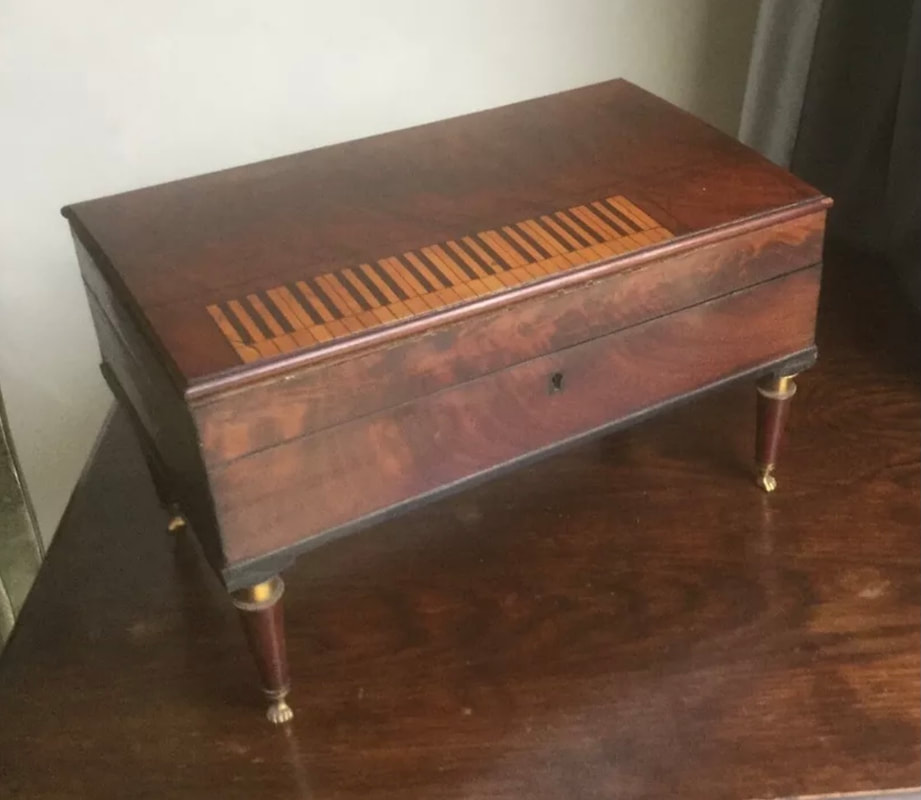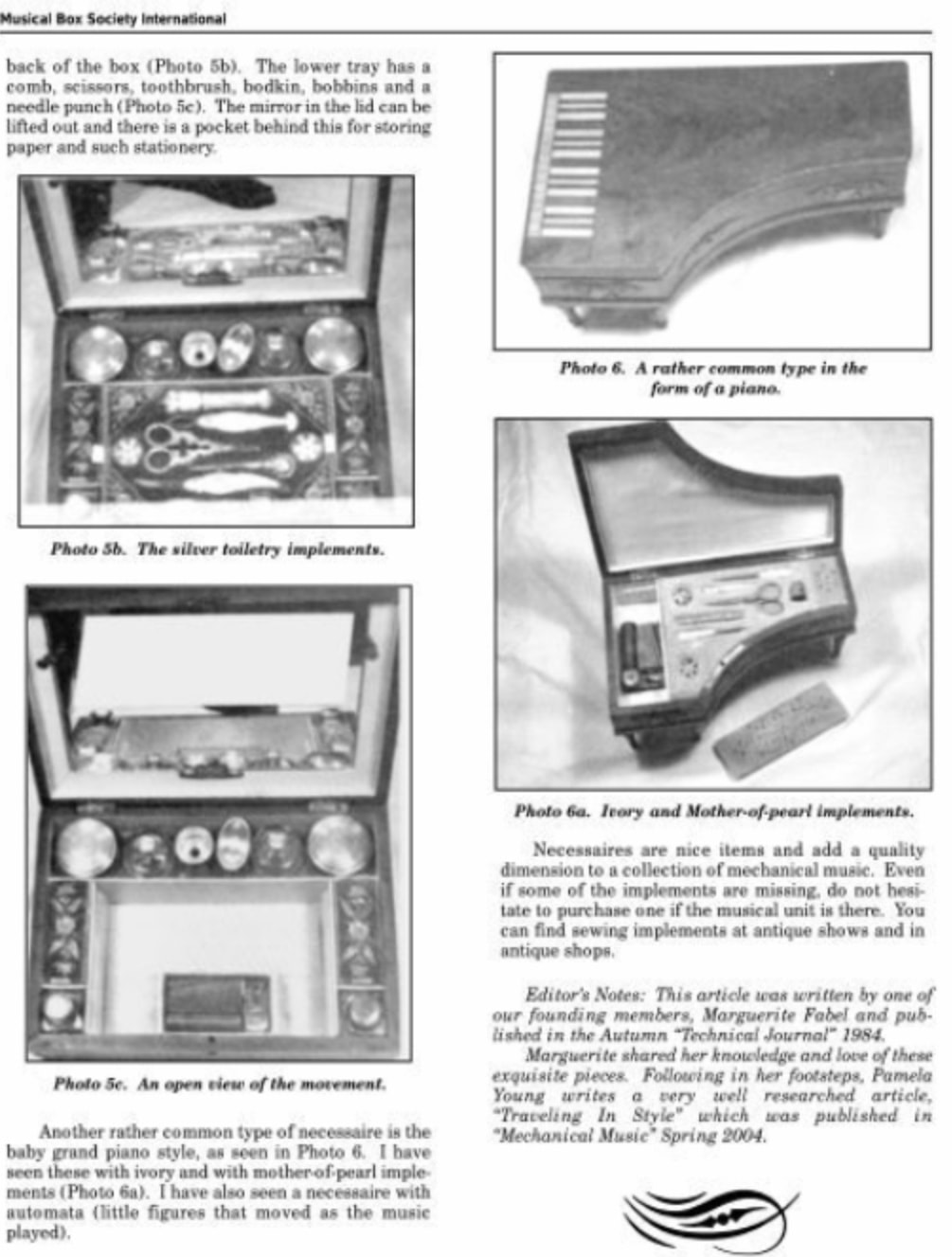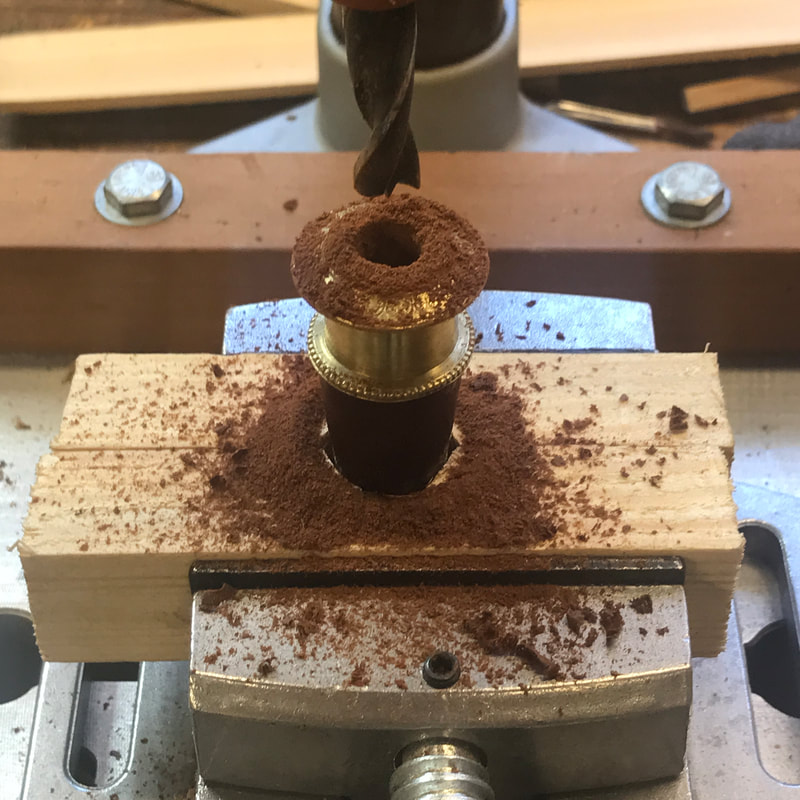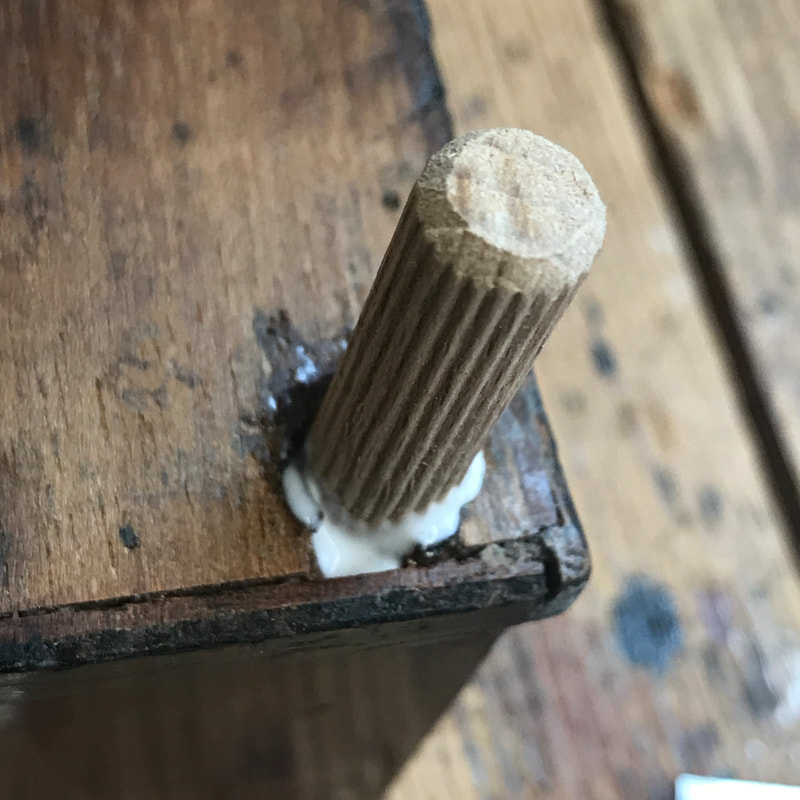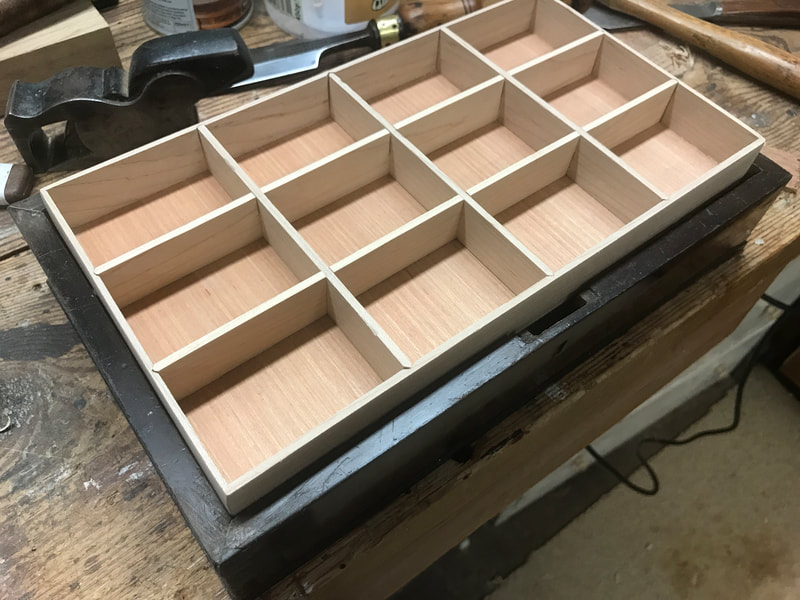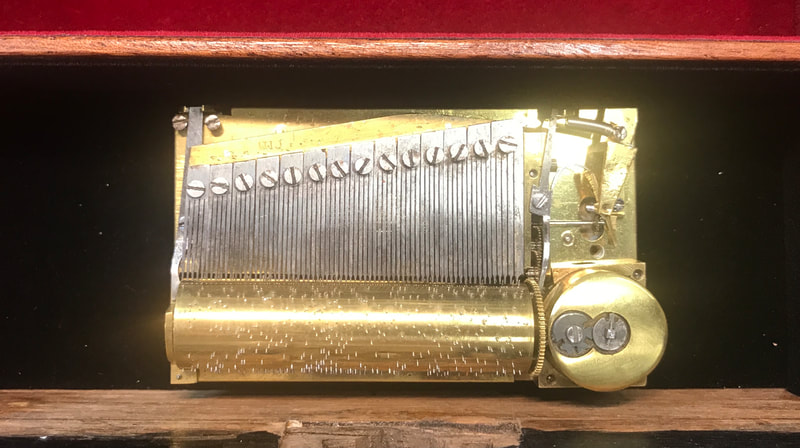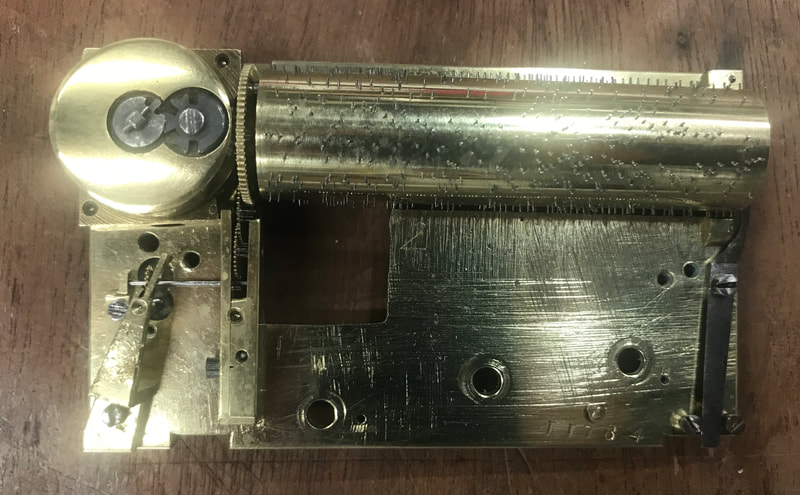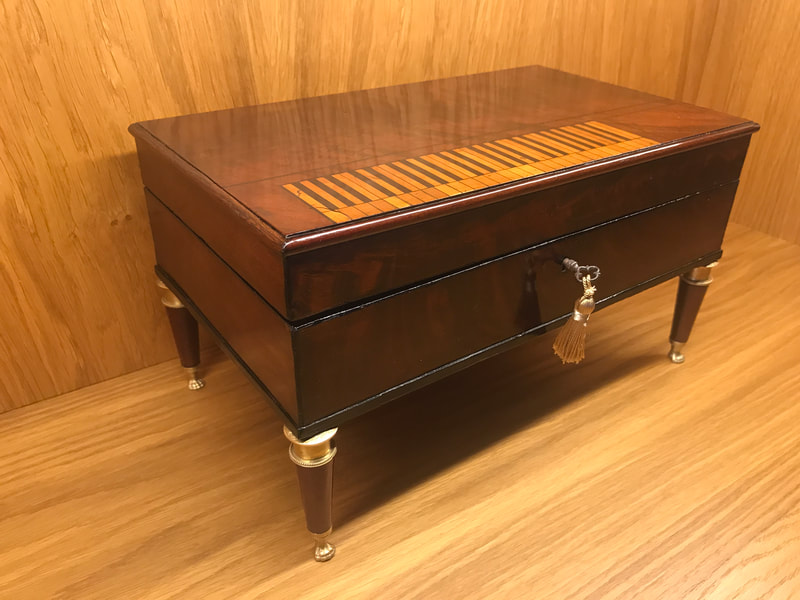2/70 Victorian "Palais Royale" nécessaire in the form of a Square Piano. circa 1830
In 2008 I restored a full size Square Piano and so when I saw this Nécessaire 'Piano' for sale I just had to buy it.
The box was not in good order, with the lid detached from its frame, wobbly legs and no interior fitments at all.
Altogether a lot worse than shown in the photos below.
Before starting work I was showing it to a friend. In the general discussion I turned to a small book 'An Introduction to Mechanical Music' published by the Association of Music Box Collectors and there was a very similar box shown. The penny dropped. This box started life as a music box.
On closer inspection I found several filled holes in the bottom of the box which proved that it was once fitted with a Tabatiére musical movement similar to those found in snuff boxes.
My plans changed a little and I began to look for a suitable movement.
I will not be able to restore this box to its original glory as I don't have any of the contents and so it will be fitted out as a musical Jewellery box for my daughter.
The box was not in good order, with the lid detached from its frame, wobbly legs and no interior fitments at all.
Altogether a lot worse than shown in the photos below.
Before starting work I was showing it to a friend. In the general discussion I turned to a small book 'An Introduction to Mechanical Music' published by the Association of Music Box Collectors and there was a very similar box shown. The penny dropped. This box started life as a music box.
On closer inspection I found several filled holes in the bottom of the box which proved that it was once fitted with a Tabatiére musical movement similar to those found in snuff boxes.
My plans changed a little and I began to look for a suitable movement.
I will not be able to restore this box to its original glory as I don't have any of the contents and so it will be fitted out as a musical Jewellery box for my daughter.
Above is a cutting showing what a Nécessaire would have looked like fitted out and with a Tabatiére musical movement in place.
The above and three images below show the box as it was when it arrived. It doesn't look too bad, but read on!
The above and three images below show the box as it was when it arrived. It doesn't look too bad, but read on!
The box
The images below show the first stages of restoration.
The interior was partly covered with pale blue flock material and the inside of the lid had silk moire fabric adhered with a hard glue.
The legs were removed to reveal that they had been 'modified' and re-attached sometime in the past as there was evidence of them having been originally dowelled directly into the bottom of the case. The repair had been badly done using a square of timber screwed to the top of the leg and then glued and pinned to the corner. This had two effects. Firstly the leg moved inboard, hiding all of the ornate brass detail at the top of the ferrule. Secondly, the timber square raised the height of the box. My plan to re-dowell the top of each leg, drill out the original holes in the box and re-set the legs where they were originally positioned has worked.
The detached lid was badly bowed and twisted. I decided to thoroughly clean all the joints and then to glue the top back onto the frame under pressure and hope that the glue held. It did, and the top is not as bowed but is still a little twisted.
Two pieces of beading were missing from the ends of the lid. These were replaced and stained to match the original colour.
The base of the box was split, so this has been filled, sanded and lightly stained.
New mahogany dividers have been made to section up the box to roughly the same layout as originally.
I've fitted a clear polycarbonate cover to protect the movement. This was was not done originally but the movement really needs protecting if it is to survive for many years.
The 'new' movement required different holes to be drilled for fixings and controls and I had to make new brass rods with a wooden knob pinned to each rod. One to stop and start the mechanism, the other to change the tune.
A brand new top tray was made using maple. This has been lightly stained and French polished then the bottom lined with velvet. The underside has also been covered with velvet so that it doesn't scrape and rattle.
Having dismantled, cleaned the brass and partly reassembled the legs, when I came to fit them I discovered that one leg was about 6mm shorter than the other three. I am at a loss to understand why this was done as the box is not badly twisted and stands true. This meant that I had to shorten the other three to the same length. In some ways it was fortuitous as it gave me the opportunity to make better stubs to fit into the feet.
The interior was partly covered with pale blue flock material and the inside of the lid had silk moire fabric adhered with a hard glue.
The legs were removed to reveal that they had been 'modified' and re-attached sometime in the past as there was evidence of them having been originally dowelled directly into the bottom of the case. The repair had been badly done using a square of timber screwed to the top of the leg and then glued and pinned to the corner. This had two effects. Firstly the leg moved inboard, hiding all of the ornate brass detail at the top of the ferrule. Secondly, the timber square raised the height of the box. My plan to re-dowell the top of each leg, drill out the original holes in the box and re-set the legs where they were originally positioned has worked.
The detached lid was badly bowed and twisted. I decided to thoroughly clean all the joints and then to glue the top back onto the frame under pressure and hope that the glue held. It did, and the top is not as bowed but is still a little twisted.
Two pieces of beading were missing from the ends of the lid. These were replaced and stained to match the original colour.
The base of the box was split, so this has been filled, sanded and lightly stained.
New mahogany dividers have been made to section up the box to roughly the same layout as originally.
I've fitted a clear polycarbonate cover to protect the movement. This was was not done originally but the movement really needs protecting if it is to survive for many years.
The 'new' movement required different holes to be drilled for fixings and controls and I had to make new brass rods with a wooden knob pinned to each rod. One to stop and start the mechanism, the other to change the tune.
A brand new top tray was made using maple. This has been lightly stained and French polished then the bottom lined with velvet. The underside has also been covered with velvet so that it doesn't scrape and rattle.
Having dismantled, cleaned the brass and partly reassembled the legs, when I came to fit them I discovered that one leg was about 6mm shorter than the other three. I am at a loss to understand why this was done as the box is not badly twisted and stands true. This meant that I had to shorten the other three to the same length. In some ways it was fortuitous as it gave me the opportunity to make better stubs to fit into the feet.
The movement
The 2/70 Tabatiére movement shown below just happened to come up for sale at the right time. It is almost certainly similar to the original in size and dates from about 1830. Possible made by one of the Lecoultre's. It has control mechanisms operated from the bottom, however, the winding disc, which uses a pull cord has been replaced with a key.
The movement is in extremely good condition with a sectional comb.
Each of the 14 comb sections has five fingers and there are no dampers so no fiddly glueing on this one!.
These sectional movements were only made from the early to mid nineteenth century and so it is approaching 200 years old.
It has been stripped, cleaned, polished, reassembled, controls modified and tested before being fitted into the box.
The movement is in extremely good condition with a sectional comb.
Each of the 14 comb sections has five fingers and there are no dampers so no fiddly glueing on this one!.
These sectional movements were only made from the early to mid nineteenth century and so it is approaching 200 years old.
It has been stripped, cleaned, polished, reassembled, controls modified and tested before being fitted into the box.
The two control arms have been fitted with extended brass rods that protrude through the floor of the box so that the mechanism can be started and stopped and the tune can be changed without needing to access any of the mechanism from within the box, thus keeping it relatively dust free.
The finished item
Unfortunately I can't identify the two tunes but they are delightful. Which one do you like most?
|
|
|
